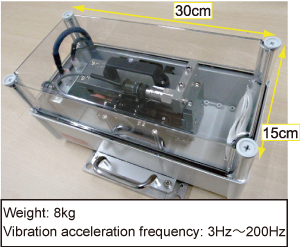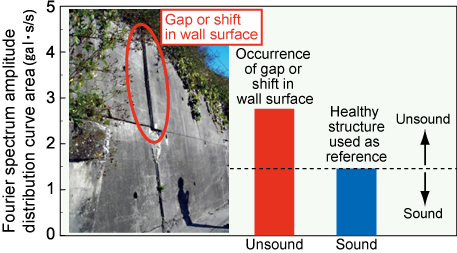5. Method to assess the structural soundness of retaining walls using a small vibrating device
- By subjecting a retaining wall to vibration, a method was developed to assess its structural soundness by deriving a Fourier amplitude spectrum from the resulting vibration acceleration wave form.
- A small vibration exciter which can be applied to the top of retaining walls was developed.
Up until now the structural soundness of retaining walls was mainly assessed through visual inspection, and there was no method for quantitative assessment. Furthermore structural soundness depends on certain changes in the backfill soil such as soil loosening and cavities, which cannot be detected through visual inspection.
Site tests and model experiment results are used to derive a Fourier amplitude spectrum, up to a fixed frequency (40Hz), from the response wave acceleration wave form obtained by vibrating the retaining wall. This is then used to calculate the area under the Fourier amplitude spectrum distribution curve. The relationship between distribution curve surface areas was then used to establish the method for determining the structural soundness of the retaining walls (fig 1). In order to make this method more practical, a small vibration exciter was developed which could generate constant vibrations of between 3- 200 Hz (fig 2).
Tests on a number of actual retaining walls demonstrated that this method produced assessment results which were generally consistent with visual inspections (fig 3) and was able to detect crevices and other alterations to the backfill soil which were not detectable by sight.
 Fig. 1 Assessment of structural soundness of retaining walls using a vibration exciter and sensors
Fig. 1 Assessment of structural soundness of retaining walls using a vibration exciter and sensors
 Fig. 2 Small vibration exciter
Fig. 2 Small vibration exciter Fig. 3 The relationship between surface area sizes determines structural soundness
Fig. 3 The relationship between surface area sizes determines structural soundness